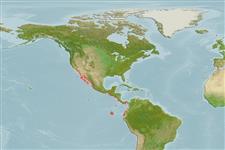>
Clupeiformes (Herrings) >
Dorosomatidae (Gizzard shads and sardinellas)
Etymology: Opisthonema: Greek, opisthe = behind + Greek,nema = filament (Ref. 45335).
Issue
Date & author Eschmeyer, pers. comm.
Environment: milieu / climate zone / depth range / distribution range
Écologie
marin; profondeur 0 - 50 m (Ref. 188). Subtropical; 36°N - 6°S, 123°W - 77°W (Ref. 188)
Eastern Pacific: Los Angeles, California to Sechura Bay, Peru. (Included in at least some accounts of Opisthonema bulleri and especially Opisthonema libertate which used to be the only Pacific species recognized).
Taille / Poids / Âge
Maturity: Lm ? range ? - ? cm
Max length : 30.0 cm TL mâle / non sexé; (Ref. 55763); common length : 20.0 cm SL mâle / non sexé; (Ref. 9291)
Description synthétique
Clés d'identification | Morphologie | Morphométrie
Épines dorsales (Total) : 0; Rayons mous dorsaux (Total) : 13 - 21; Épines anales: 0; Rayons mous anaux: 12 - 23. Body moderately deep and compressed; posterior edge of gill openings with two clearly visible, fleshy, protuberances; gill rakers numerous, 41 to 69 on ceratobranchial (in fish longer than 14 cm total length); last dorsal ray elongated and filamentous; back gray-green with silver-white flanks and a black spot behind the gill slit followed by a yellow lateral strip (Ref. 55763). The filamentous last dorsal fin ray distinguishes it from members of any other eastern Pacific clupeoid genus. Separated from other eastern Pacific Opisthonema by having 41 to 69 lower gill rakers in fishes over 14 cm standard length.
Usually found near shore, forming schools. Feeds on crustaceans and pteropods.
Life cycle and mating behavior
Maturities | Reproduction | Spawnings | Egg(s) | Fecundities | Larves
Whitehead, P.J.P., 1985. FAO Species Catalogue. Vol. 7. Clupeoid fishes of the world (suborder Clupeoidei). An annotated and illustrated catalogue of the herrings, sardines, pilchards, sprats, shads, anchovies and wolf-herrings. FAO Fish. Synop. 125(7/1):1-303. Rome: FAO. (Ref. 188)
Statut dans la liste rouge de l'IUCN (Ref. 130435)
Menace pour l'homme
Harmless
Utilisations par l'homme
Pêcheries: intérêt commercial mineur; appât: occasionally
Outils
Articles particuliers
Télécharger en XML
Sources Internet
Estimates based on models
Preferred temperature (Ref.
123201): 20.5 - 28.4, mean 25.4 °C (based on 72 cells).
Phylogenetic diversity index (Ref.
82804): PD
50 = 0.5312 [Uniqueness, from 0.5 = low to 2.0 = high].
Bayesian length-weight: a=0.00912 (0.00433 - 0.01920), b=3.04 (2.87 - 3.21), in cm total length, based on LWR estimates for this (Sub)family-body shape (Ref.
93245).
Niveau trophique (Ref.
69278): 3.3 ±0.38 se; based on food items.
Résilience (Ref.
120179): Haut, temps minimum de doublement de population inférieur à 15 mois (Preliminary K or Fecundity.).
Fishing Vulnerability (Ref.
59153): Low vulnerability (20 of 100).
